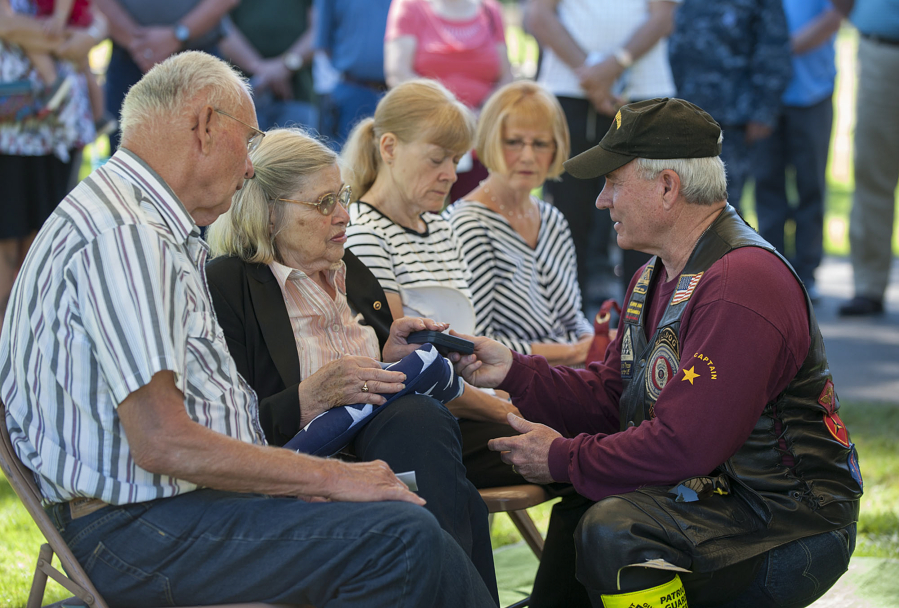On the same day that military officials announced the identification of Vancouver soldier William Butz, they issued a similar release involving another Southwest Washington family.
John England, a U.S. Navy ensign, died aboard the USS Oklahoma after the Japanese attacked Pearl Harbor. The POW/MIA agency announced on Aug. 5 that some of England’s remains have been identified and were being returned to the family.
In addition to a feeling of joy — “I can’t even begin to tell you” — Bethany Glenn had another reaction. Mission accomplished.
“It’s been an eight-year-long journey,” the Kalama resident said.
Unlike Pfc. Butz’s family, Glenn knew her grandfather’s remains were buried in a national cemetery in Hawaii. Glenn has known since 2008, and she even knew the grave in the Punchbowl where England had been buried as an unknown war casualty: P-1001.
In 2011, “we went to the 70th anniversary of Pearl Harbor, and went to the grave he was in.”
Betty and Gary Hein — Butz’s sister and brother-in-law — and Glenn are among at least three Southwest Washington families that have had the remains of their war casualties returned in the last four years.
Different paths home
The remains of Army paratrooper Mike Kight were discovered buried in a farmer’s field in the Netherlands in 2011 and were returned to White Salmon in 2012.
Butz, Kight and England illustrate different examples of servicemen who went missing in action.
Butz was buried on enemy soil in 1950; his remains were returned to American hands in 1954 as part of an exchange between the opposing militaries. But it took more than 60 years for a positive identification.
Kight had his wallet on him when he died, said Vancouver veteran Lynn Vaughn. Vaughn led the Patriot Guard Riders who escorted Kight’s remains from Portland International Airport to White Salmon in 2012.
England died on an American Navy base, and his remains have never been out of the hands of the U.S. military. There were even partial identifications for England and several shipmates in 1949, but that information was filed away.
As a member of an involved family, Glenn was able to describe some of the process. After the war, forensic anthropologist Mildred Trotter was hired to oversee the process of identifying the remains of about 400 sailors and Marines that were recovered from the battleship. Dental records were used to identify 27 skulls or jawbones — including England’s skull.
“It was not military policy to send partial remains, even when partial remains had been identified,” Glenn said.
Military officials suggested using a mix-and-match of suitable bones to create 27 improvised skeletons and return those remains to families.
Trotter was horrified, according to accounts, which marked the end of that project.
A Pearl Harbor survivor, curious about all the graves marked “Unknown Dec. 7, 1941” started researching about 30 years ago and came across Topper’s paperwork. Bob Valley, whose brother was aboard the battleship, then became a coordinator for the Oklahoma families.
“Valley contacted me in 2008,” Glenn said. “The Navy hired a genealogist, Dee Dee King, who found relatives and got DNA from 80 percent of the families.”
Glenn, her sister and a cousin provided samples; it was the cousin’s DNA that proved they were related to the remains that had been identified as John England.
But military officials, she said, “were still dragging their feet.”
Some felt that recovering bones for further testing would mean disturbing the sanctity of the unknowns’ graves. One felt that the unknown sailors were already home, buried with their shipmates. And some still didn’t want to return partial remains to the families.
Those attitudes finally changed, Glenn said, and now her family will get to bury her grandfather’s remains. It’s the skull that was identified in 1949, she said, but that’s enough for them.
Patriot Guard Riders
Vaughn, assistant state captain of the Patriot Guard Riders, led the contingent that escorted Pfc. Butz’s remains from Vancouver Funeral Chapel to the soldier’s final resting place Friday.
Vaughn said he’s participated in just one other homecoming like it, escorting Kight’s remains.
The paratrooper was killed in September 1944 in the Netherlands during Operation Market Garden. After German forces overran Kight’s position, they buried the dead paratrooper in his own foxhole, Vaughn said.
His remains were discovered in 2011 by three Dutch hobbyists who were walking across a farmer’s field with metal detectors, looking for wartime artifacts.
They detected shell casing … and when they started finding bones, they notified authorities. Kight’s ashes were laid to rest on May 19, 2012, in White Salmon.
There was an interesting follow-up to the story, Vaughn said.
“I personally kept in email contact with Paul Geutjes, Rick Hermsen and Mario Wijinhoven,” he said.
Vaughn emailed them photos of the service, and Geutjes replied with a photo showing the three men drinking a toast to mark the fallen soldier’s return home.
In 2013, the three men visited White Salmon to see Kight’s final resting place and meet his family.
After a ceremony at the cemetery, Geutjes presented Vaughn with a section of a World War II Army parachute they had recovered from the same area. It obviously was the parachute of an 82nd Airborne soldier who fought — and possibly died — with Mike Kight that day, Geutjes said.
Bob Hembree, one of Kight’s family members, received a similar parachute section, as well.
Vaughn said he and Hembree will donate them to the Veterans Memorial Museum in Chehalis, along with the full report from the Joint POW/MIA Accounting Command. They’ll be part of a display that will tell the story of Pfc. Mike Kight.




